Do you want to learn how to start a blog in 7 simple steps? You have come to the right place as I will be showing you how to do just that.
All you need to do is follow my step-by-step guide and you’ll discover the tactics I used to make multiple 6-Figures with my blog in just a few years.
Most of the advice on the internet regarding how to start a blog is outdated.
Taking blogging advice from someone who started a blog ten years ago is like asking directions from someone who still relies on an old-fashioned map and compass.
Blogging is on a much different landscape today, and the best way to start a blog is to update your strategies for the 2020s using practical blogging tips.
That’s why in this post, you will learn how to start a blog in 7 simple steps. Here’s what we’re going to accomplish in this post:
- Choose a Host to Set up your blog.
- Choose your blog’s niche.
- Install WordPress.
- Choose your blog’s theme.
- Install Recommended WordPress plugins.
- Write and publish great content
- Promote your blog
Now, as you follow along in this article, also make sure to subscribe to my YouTube Channel to keep learning for free as I publish more videos about blogging like a pro.
How To Start A Blog In 7 Simple Steps
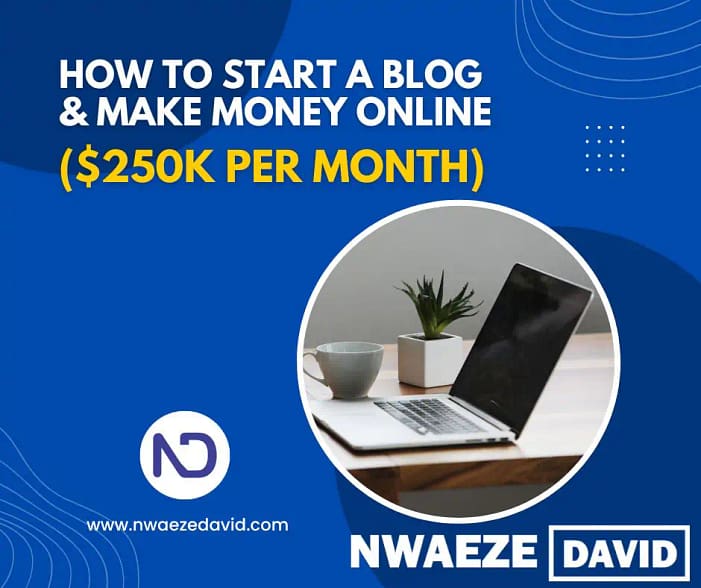
Choose a Host to Set Up Your Blog
Before you proceed with this step, I recommend you go through our List of Best Web Hosting Services and choose from the listed hosting options for your new blog.
For the sake of this blogging tutorial, we’ll be using Hostinger as an example. Here’s my favorite beginner setup at the lowest cost with the best features (based on my 10+ years of experience):
- Click here to go to Bluehost.com ( Note: The highlighted link will get you a discount and reduce the total amount you'll pay) and click Get Started Now.

Go ahead and select the hosting plan you want to work with. We do recommend choosing between Choice Plus Plan, and the Pro Plan.
Any of these plans will give you enough space to build your blog and start bringing in revenue to upgrade later.
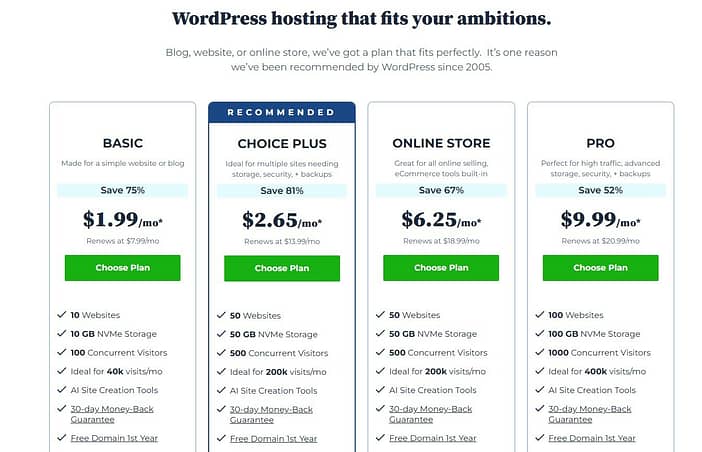
Now that you have chosen a hosting plan, it's time to register your domain.
Remember, as a Nwaeze David student, visiting bluehost.com from my website gives you a great discount and one of the discounts is that you'll get a free domain for 1-year on bluehost.
So, go ahead and enter the domain name you want to use (i.e., nwaezedavid.com).
Here are a few other things to consider when choosing a name through a domain name registrar:
- Your name should be memorable and not too difficult to type.
- Don’t confuse people with difficult spelling; just keep the name easy to spell and pronounce.
- Avoid using numbers and hyphens in your domain, as it can confuse people.
- Try and keep your name broad if you need to pivot to an adjacent niche.

The domain name you choose should be unique and also related to the niche that you want your blog to represent, except in rare cases where you want to use your name as the domain name just as I did.
One thing you should keep in mind while choosing a domain name is the primary keyword of your niche. Try and include the keyword in the domain name.
For example, if your blog is in the insurance niche, you can use something like insuranceblog.com or insuranceinfo.com, etc.
Once you enter your preferred domain in the box as shown in the above image, go ahead and search for it's availability.
If the domain is available, proceed to the next step.
Make Payment and Begin Your Blog Creation: As you can see from the image below, you will be getting a huge discount because your visited bluehost from our website which is amazing right?
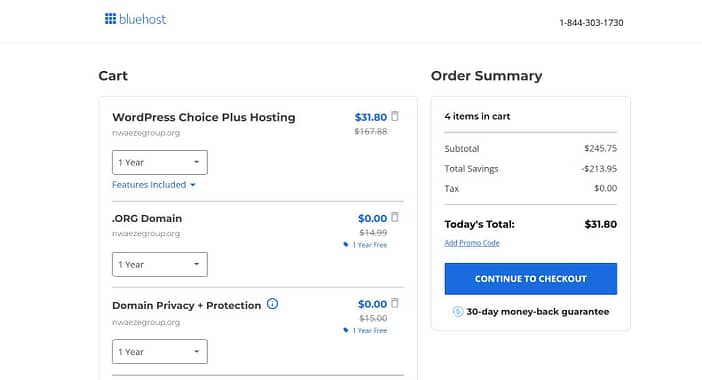
Click on 'Continue to Checkout' to create your account.
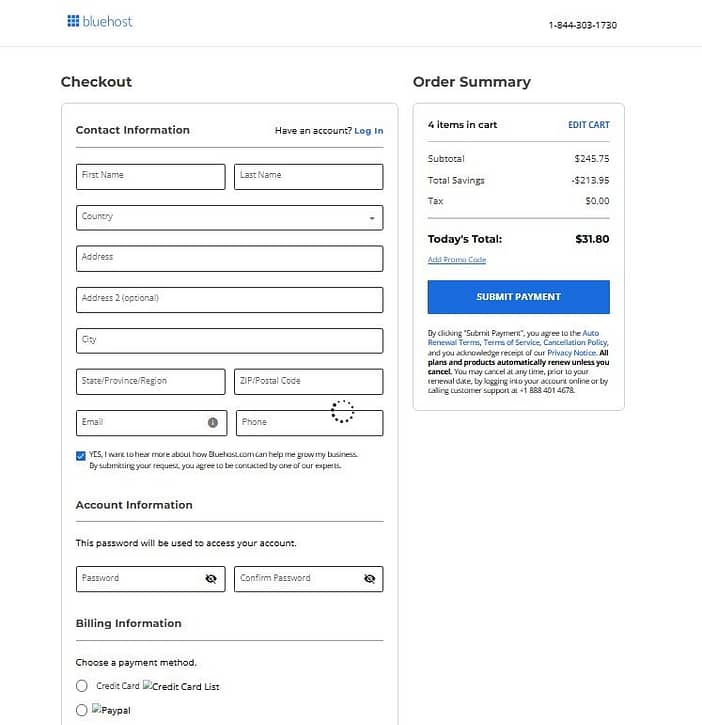
Now, carefully enter your account information so that your bluehost dashboard will be setup immediately.
It is with this account that you can create and manage your website.
After you are done entering your details, go ahead and make payments. Once, you have completed your purchase, you can then log in to your Bluehost account.
- Answer the onboarding questions or skip them, but choose “blog” when prompted.
- Click “skip” when it comes to choosing your theme. (We’ll get that sorted out later.)
- From the Bluehost dashboard, click the WordPress button on the top right, and you’ll end up on WordPress.
Congrats! You now have your own self-hosted WordPress blog!
Choose Your Blog’s Niche.
At this point, we all know that your blog needs a niche, so what is it?
Whether it’s marketing, cooking, Crossfit exercises, vegan dogsitting, underwater parkour, solo dancing – whatever crazy personal blog topic, there are endless things to blog about.
Here’s the problem most people face:
So many professional bloggers will tell you to start with something you’re passionate about because it helps you “maintain a consistent writing schedule and push through failure to succeed.”
They’ll also tell you to choose a niche at the intersection of passion, skills, and experience. But, if you want to start a website to make money blogging, then using this model is very much flawed because it’s missing one major component: ‘You as a brand’
As a blogger, you need to understand that you are the brand.
When choosing your niche, it’s time to brainstorm about the following:
- What you want to teach easily.
- Where you may already have experience.
- Any leverage you may have in an industry.
- Where you can extract value from the market.
The next step is uncovering your expertise.
Note: This shouldn’t be what you think you are an expert at or want to be an expert at but what you have a proven track record of succeeding at.
Your expertise enables you to make money easily as a newbie with a new blog.
The third step is taking an honest look at the market.
Ask Yourself; How can you really monetize this market? Just because you’re passionate about a particular niche doesn’t make it the right niche for you.
And last but not least is the leverage you have in your life when it comes to that niche.
Here are some important questions to ask yourself:
- What levers can you pull?
- Do you have connections?
- Insider information on a market?
- An incredible skill set compared to most people?
- How are you uniquely positioned to leverage any and everything in your life that others can’t keep up with?
Install WordPress.
A Self-hosted WordPress is the best blog platform for new bloggers because it gives you freedom and flexibility to design the type of website you want.
The good news here is;
Bluehost automatically one-click installs WordPress right from your hosting dashboard, making starting a blog a piece of cake.
You can easily pick a theme the first time you get to your dashboard or you can do that later on. I will actually recommend you wait a little as I'm about to show you a list of great themes to choose from.
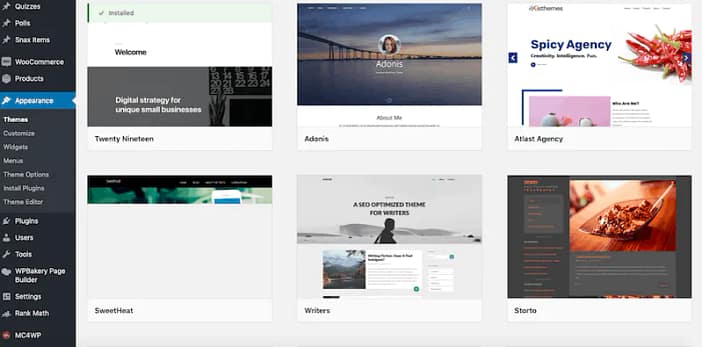
There are plenty of attractive free WordPress themes, including free blog themes.
However, if you want to pick your theme later, you can skip this step by clicking on the “Skip This Step” option at the end of the page.
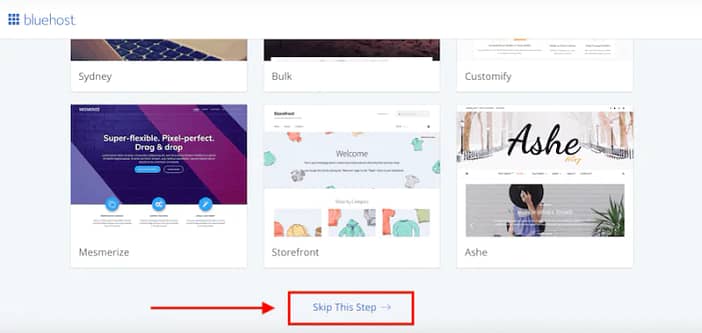
You get to a new blog page where you need to click on the “Start Building” option.
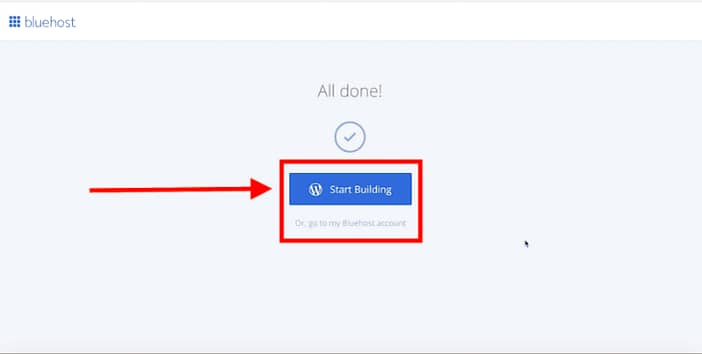
Next, select the type of site you plan to create, and WordPress will help you with prompts. You can also click “I don’t need help” to go right to your dashboard.
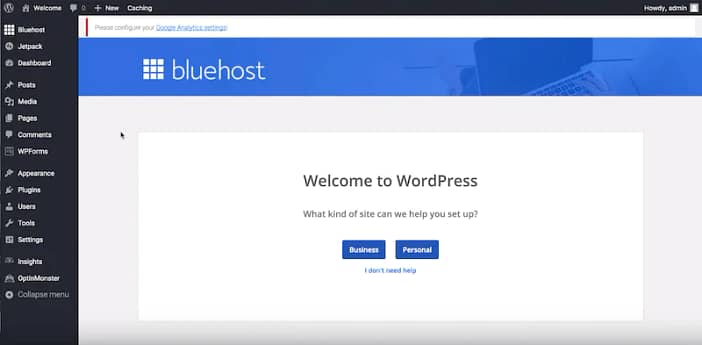
Finally, enter your “Site Title” and “Site Description”. From here, I recommend you spend some time making yourself familiar with the WordPress dashboard.
Are you ready to start your blog? Get started for just $2.95/month (63% off your hosting plan) with my link below:
Choose a Theme for Your Blog.
You will need a good theme to design a professional blog that will really make you money. A WordPress theme is a collection of templates, files, and stylesheets that dictate your blog design.
Right now, your blog might look something like this:
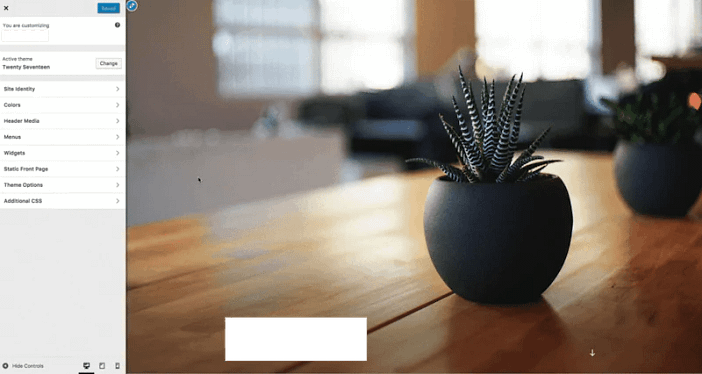
When you install WordPress newly, the default WordPress theme will be installed automatically, and on the left is a menu that helps you change its appearance.
Now, there are two options when it comes to themes:
Option 1. You can get a free theme with limited options or a paid theme.
I recommend you pick a premium theme like ThriveThemes or Kadence, which are the best for most great bloggers. They may be a little expensive but totally worth it.
Option 2. You can buy a professional WordPress Theme from Envato Market also known as ThemeForest.
How To install a new theme on Your WordPress blog
The first thing you need to do is log in to your WordPress account (admin page) if you are not already logged in.
You can always access your WordPress login page by going to yourdomainname.com/wp-admin.

Once logged in, your WordPress dashboard looks something like this:
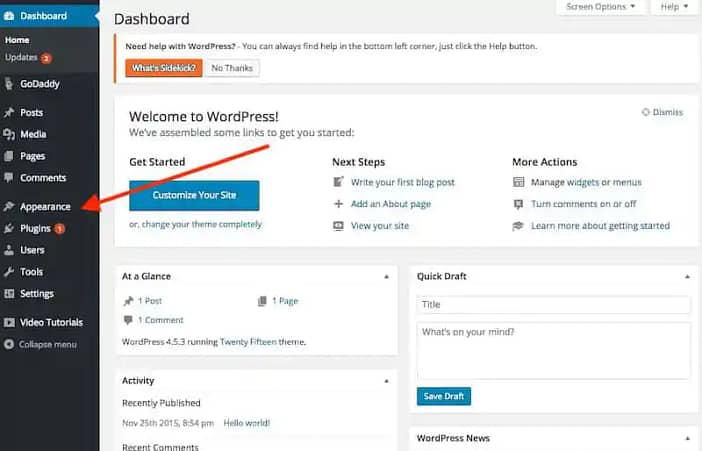
Here, click on the “Appearance” option from the sidebar menu.
Next, select the “Themes” option from the “Appearance” section.
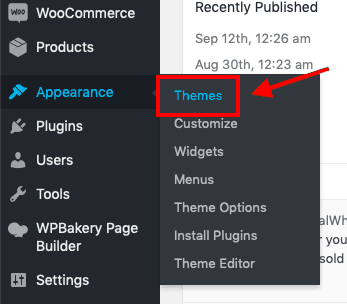
To search for the theme options WordPress offers, click the “Add New” button at the top of the page.
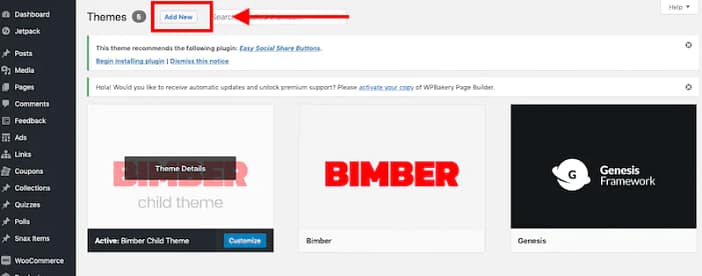
As you can see below, there are many free themes.

Before picking one for your blog, preview as many WordPress themes as possible to see if it’s what you want.
To install an external theme from a site like ThriveThemes, Kadence, iThemes, and ThemeForest or Envato, etc.
All you have to do is go to “Appearance” – “Themes” and click “Add New,” upload the zip file, and click Install.
Are you ready to start your blog? Get started for just $2.95/month (63% off your hosting plan) with my link below:
Install Recommended WordPress Plugins
Plugins are tools that integrate with your website and extend its features.
When starting a blog, choosing the best ones for SEO and site speed is essential.
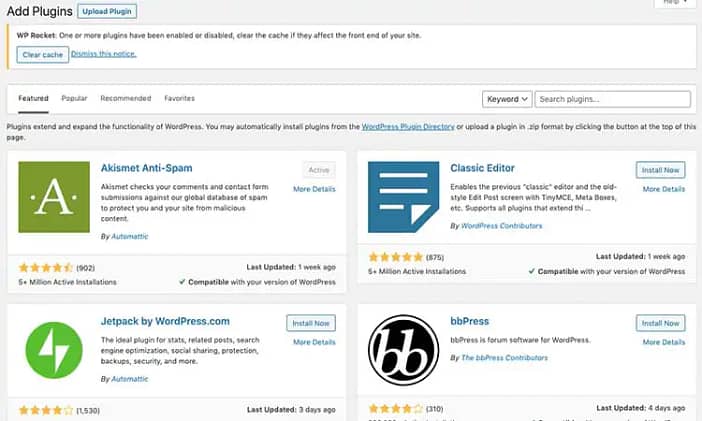
Here’s a list of four of the best ones you should add to your blog:
1. Elementor Pro.
Elementor Pro is a WordPress landing page builder, and it’s the tool I used to create my home page and about page.
They have a free version of Elementor, but the Pro version takes it to the next level with much better templates.
2. WP Optimize (Image Optimizer).
WP-Optimize compresses all of your images and screenshots so that they are smaller files and your pages load faster.
I’ve tested many different image compression tools, and WP-Optimize has been the best.
3. WP Rocket.
WP Rocket is an all-in-one site speed plugin that can simplify HTML, CSS, and JavaScript, integrate with your CDN, reduce database bloat, and more.
I’ve tried other speed tools like Autoptimize and had some issues with them. WP Rocket is the best, in my opinion.
You can get started with WP Rocket for $49 per year.
4. RankMath SEO.
I use RankMath SEO to manage my sitemap, robots.txt, page title, and meta descriptions. Another great option is AIOSEO (All in One SEO).
Create Great Content for Your Blog.
Congrats!
You started a blog and are ready to start blogging by creating your first blog post.
This is where the rubber meets the road.
One thing first:
Blogs are no longer places where you write updates and gain a following.
They are now Google-driven websites that require organic search traffic.
This is where on-page SEO comes into play.
When you write your first blog post (and every one after that), focus on one main target keyword, and here’s where you should include it:
- Put the keyword in your blog’s permanent URL.
- Include the keyword in the title of your post.
- Add your keyword to the first or second paragraph.
- Include the keyword inside of your headings.
- Add the keyword throughout your blog post.
Once you have a list of the top 5-10 keywords (topics) you want to cover, it’s time to start writing.
Remember, in addition to text, blog posts with audio, video, photos, infographics, and other visual content perform the best and keep readers engaged.
It’s also essential to write content that matches Google search intent and compels them to take action on your blog.
Moreover, use keyword rank tracking software to track the position of your various keywords in search engines as time goes by.
Writing Blog Posts that Match Search Intent.
When planning your content strategy, consider what your reader wants when performing an online search for your target keyword, you can use DIIB for that.
This concept is the psychology of search intent and is at the heart of your blog content strategy:
For example, your target keyword is “How to Get Rid of Pimples.”
When you search for this term, you’ll see many new blog posts feature titles, including additional terms like Fast, Overnight, Quickly, and Home Remedies.

This data shows that most people that want to get rid of pimples want them gone as quickly and discreetly as possible. And Google’s PageRank is pushing these articles to the top.
What does this mean for your content strategy?
You should get to the point and offer a list of the best ways to get rid of pimples quickly.
Don’t write a long post about “The Ultimate Guide to Getting Rid of Pimples.”
And don’t start your post with the heading “What Are Pimples?” like many SEOs did in the past.
Instead, match search intent and provide the solution your readers are looking for by understanding the meaning behind their search.
You accomplish this by looking at which additional terms are included in currently ranking content’s title tags and reverse-engineering the search.
While you don’t have to be a professional writer when starting a blog, it’s essential to understand basic sentence structure and proper grammar.
For example, short paragraphs, bullet points, and images help break up long, monotonous blocks of text and keep readers engaged.
You can also check out my guide to the best grammar checkers to use with your blog this year and why I use Grammarly.
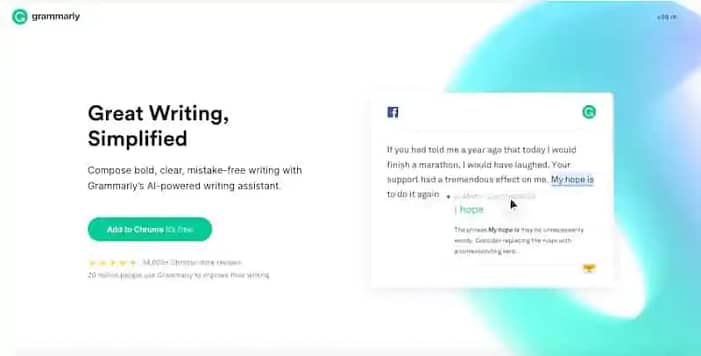
Extra Tips to Improve Your Writing.
- Your blog posts should always provide value to your readers. Write with a clear beginning, middle, and end outline structure. You can make even the most mundane topics interesting if you understand story arcs and hero’s journeys.
- Present your blog content attractively and make it easily accessible to your readers. Make sure both textual and visual content in the blog are high-quality.
- Format your headings correctly with H2 and H3 tags, and use bulleted lists and images to break up long lines of text. No paragraph should be longer than 3-4 sentences.
- Make your first blog posts conversational to build a connection with your audience.
- Use readable fonts and use white space to keep your blog posts easy on the eyes.
- Add bullet points to help readers skim down the blog without missing anything critical.
- Double-check for typos and grammatical errors.
- Bold some text to make it stand out.
Remember, a blog is a living thing that you can update over time. So don’t try to make your content perfect – get your blog online and publish it without fear – you can continually update it later.
Create Your Home and About Pages
Before starting a blog, you should have a few pages in your blog’s top menu navigation so that readers quickly understand your blog and find important information.
In my blogging course, Pro Blogging Academy, I extensively cover the pages you need to launch your blog and start on the right foot.
I call them “Your Major Four” pages, and they are:
1. Home Page.

We all know what a home page is – it’s the main URL of your website.
This page shouldn’t include every little detail about your site – its purpose is to sell your unique value proposition in two seconds or less.
If a reader hits your home page and doesn’t quickly understand what your site is about, they may bounce and never return.
You edit your WordPress home page with a WYSIWYG (what you see is what you get) page builder like Elementor.
This tool allows you to drag and drop content blocks, including text, images, videos, color blocks, and more.
A good home page should contain the following:
- A slider or hero image with a headline and subheadline.
- A small section to tell readers more about what your blog is about.
- The primary call-to-action button takes readers to a significant page, post, or email list opt-in form.
- Internal links point to your important content to make it easy for readers to navigate your site.
2. About Page.
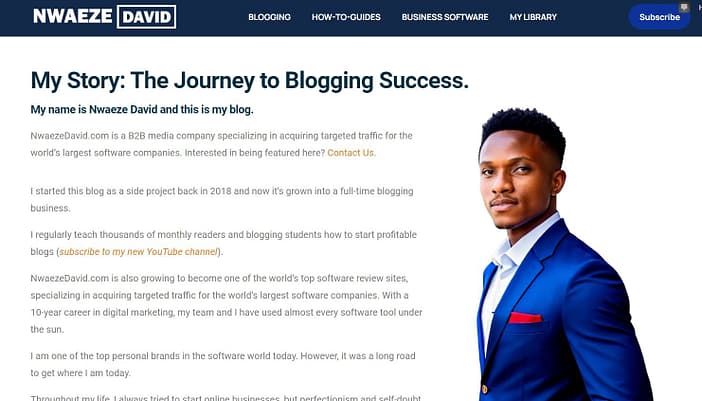
The About Page of your blog should cover everything about you – who you are, what you stand for, and what your blog is about.
This particular section of your blog will help you connect with your readers on a deeper level, so don’t hold back.
Make sure to write about the following:
- Who you are.
- What made you decide to start your blog.
- Your expertise or background to build trust with your readers.
- The pain point you’re solving and how you’ve dealt with the same struggles as your audience.
- Your success story.
- A call-to-action.
To keep readers engaged, You can write your About page like a story.
People don’t necessarily want to read about all of your recent professional accomplishments.
This story isn’t the place to brag about yourself but to allow people to understand who you are.
3. Blog Post Template
Your blog post template page is fundamental when starting a blog.
Your blog mainly consists of posts; you must have this template dialed in before publishing posts.
Your blog posts need to be:
- Easy to read text by making sure you use large enough font in black with a white background. (Do NOT break this rule )
- Your text should be no wider than 850px. Once you start going beyond this, your readers have to look too far from left to right, making it difficult to read.
- They need to have proper line spacing. If you take this post you are reading right now, for example, you will notice that I have no more than three lines of text before a paragraph break.
Those are the main points you need to address, but one thing that is also super helpful when starting a blog is looking at sites you want to model (not copy) and reverse engineer what they are doing.
This concept is true for every area of your blogging business, especially in the blog post design.
4. Blog Archive
Every blog has a “/blog” page like Nwaezedavid.com/blog; your blog shouldn’t be the exception here.
Note: A current trend in blogging is to use a more complicated page structure, but if you start a blog from scratch, use a standard /blog archive page that chronologically displays your posts.
A good rule of thumb to follow here with this page is to make sure that it is simple and displays no more than ten posts per page.
The same advice applies here as above; you want to model (not copy) sites in your niche that are getting great results.
5. Contact Page
Having a page with a contact form means that people can get in touch with you when needed.
Ensure that you have a confirmation message when someone submits their form.
This page can be as simple as:
Thank you so much for reaching out. We’ll get back to you as quickly as possible.
Plan Your Future Content
Another common question is how to prioritize new blog post ideas.
This should be based on keyword metrics, including search volume, difficulty scores, and how well you think you can rank for a keyword.
You can keep track of this inside of a simple spreadsheet with columns for your future posts, including:
- Target keyword.
- Blog post title.
- Monthly search volume.
- Word count.
- Priority.
Analyze Your Content
You need to use analytics tools to analyze your content’s performance. Tools like Google Analytics and Ahrefs do this well.
Since a Google Analytics account should already be on your blog, you can go to your GA dashboard to view metrics like site visitors, average time on page, total page views, and tons of other interesting stats.
You can view traffic to individual blog posts over any period and compare it to previous periods to see if your traffic is increasing or decreasing.
Are you ready to start your blog? Get started for just $2.95/month (63% off your hosting plan) with my link below:
Promote Your Blog.
To promote your new blog, the best strategy is to do whatever it takes to build links to your blog.
Links are like the currency of the Internet.
The more you have, the more Google will take you seriously and rank a new blog post quickly after you publish it.
Here are the top strategies to promote your blog:
Guest Blogging
Guest blogging is one of the best ways to promote your blog.
It’s a great way to build authority in your niche, meet other bloggers, get exposure on various forums related to your niche, and get backlinks.
Guest blogging is a hustle that includes cold email outreach and relationship building.
First, don’t think about the benefits you’ll get from backlinks.
You have to provide value to others.
Said differently, in internet marketing, you must provide value when writing guest blog posts.
For a full rundown of this strategy, read my guide on guest blogging
Link Building
Although guest posting is one strategy to get links to your blog, there are plenty of others.
First, the best form of link building is passively getting links without involvement or outreach.
Sounds like a dream, right?
People naturally link to the best content they can find.
So how do you make sure your blog posts are “linkable”?
When starting a blog, your content needs to be unique and high-quality. That’s the basic entry fee to get into the game.
To take it to the next level, add visual elements to your blog posts. These can be infographics, videos, case studies, statistics, and any other unique content that doesn’t exist anywhere else.
Here are some other link-building strategies to try out after you set up a blog:
- Broken link building: Use a tool like Ahrefs to find blogs in your niche with broken external links. Send them an email that their link is broken and your resource is a better option. This strategy is great because you’re helping the blog fix its 404 error and (hopefully) getting a link simultaneously.
- Link reclamation: Input your blog’s URL into the Ahrefs Content Explorer tool to find instances where your brand is mentioned but not linked. Here, you can reach out to the post’s writer, thank them for the mention, and ask if they can add the link.
- Link partnerships: Form relationships with other bloggers in your niche to get links in their guest posts and vice versa.
- Competitor research: View which websites are linking to competitors to get new sites to reach out to.
Search Engines and Blogging
You could have the best blog in the world – if you don’t have visitors, it doesn’t matter, does it?
So how do you get people to your blog? The answer is straightforward – through search engines.
Search engine listings are the primary method used by potential readers and subscribers to find out about new blogs.
If they can’t find you, or even worse, if you aren’t ranked highly in search results, they won’t know you exist!
When you create a blog, remember that content readers will love is excellent, but you also need to ensure people can find your blog in search engines.
The secret of achieving good rankings is not a secret at all – it’s simply about making sure Google knows what each page of your blog is dedicated to.
For example, instead of just saying, “This post is about this” or “This post is about that”, use language that reflects what future readers might type into Google when searching for information on the topic covered by your article.
Think of it as an excellent way to ensure that Google knows what your page is about – then you’ll naturally start appearing for relevant search results.
SEO title tags
SEO title tags appear in search engine results and get people to click on your blog.
It can be the same, different, or similar to the title of your articles, but most importantly, it needs to make sense when people search for specific words.
Also, search engines will truncate the title tag to about 160 characters, so you should consider this as you think of your SEO title.
Don’t forget to include the main keyword/s you are targeting in your title.
Meta description
Another on-page SEO factors to consider are meta description. These are the words that appear beneath your blog post in Google.
They are displayed on your page, so you have complete control over what Google thinks your post is about.
Use these to give readers a good idea of what to expect from your blog.
Sitemap
This helps search engines direct search engine bots to your blog and also lets them know about all the pages you have.
You should submit a sitemap via Google Search Console, as this ensures that new content added to your blog can be indexed as quickly as possible.
Pay attention to categories and subcategories when creating your directory structure, as this will be shown in the sitemap.
Ensuring that you give the search engines as much information as possible about your blog is very important.
Widgets
An excellent blog for SEO sometimes means displaying information in a widget and your post.
This means including RSS feeds, author info, and related posts to your blog posts will help the search engines direct relevant readers to your site.
Widgets can also be great for subheaders, giving you additional functionality for your blog.
On-Page SEO
You need to format your blog posts to rank on search engines properly.
To do that, you must ensure your target keywords are in the URL, the H1 (title), the first H2 in the form of a question, and throughout the content.
You can use tools like Jasper and SurferSEO to optimize your blog posts for SEO.
Mistakes That Can Kill Your Blog Growth
If you’ve been blogging for any length of time and you do not see the results you want, your approach may be wrong.
It’s easy to become discouraged when your blog isn’t growing, but it doesn’t have to be that way.
Focusing on Inputs Instead of Outputs
One of the most common mistakes bloggers make is focusing too much on inputs instead of outputs.
By inputs, I mean things like researching topics, writing content, creating images, and so on.
While these are all critical pieces, they don’t directly lead to blog growth.
What does lead to growth is getting your content out in front of people who need it – or, put another way, output.
So instead of focusing solely on creating content, focus some energy on things that will help get your content seen by more people, such as link building and social media marketing.
Link Building
Link building is integral to growing a blog because it helps build credibility with search engines and increase visibility in search engine results pages (SERPs).
Unfortunately, many bloggers shy away from link-building because it can sometimes feel uncomfortable or awkward.
But if you want to grow your blog, link-building is essential – so make sure you’re doing it!
Having a Content System
If you’re running a content-driven business – whether a blog or something else – then having a content system is crucial for success.
A content system helps ensure that articles are being published regularly and efficiently so that readers always have something new and exciting to read about each week or month (depending on how often you post).
Not only will this help keep readers engaged with your content, but it will also give them a reason to come back again and again.
Trust the Process
When starting a new blog or website, it’s easy to get caught up in wanting to see immediate results – but unfortunately, that isn’t always realistic.
It takes time for blogs (and websites) to gain traction in search engines and start bringing in traffic organically – so don’t expect overnight success.
Rome wasn’t built in a day, after all; trust the process and keep plugging away at your goals until, eventually, you’ll start seeing results.
Having Unrealistic Monetization Expectations
Finally, unrealistic monetization expectations can lead to disappointment and cause people to give up on their blogging journey before they’ve even started.
It’s important to remember that most bloggers don’t make money until they reach certain traffic levels – often upwards of 100K visitors/month or more, depending on their niche.
So if monetization isn’t happening right away for you, don’t worry – keep focusing on consistently putting out excellent quality content over time; eventually, those efforts will pay off.
How to Start a Blog [Infographic]
You are free to post this infographic to your own blog! But, remember to add a link back to my blog as the source.
I’ve also surveyed and researched the biggest challenges for new content marketers based on the stage of their blog’s growth.
Here’s what I found:

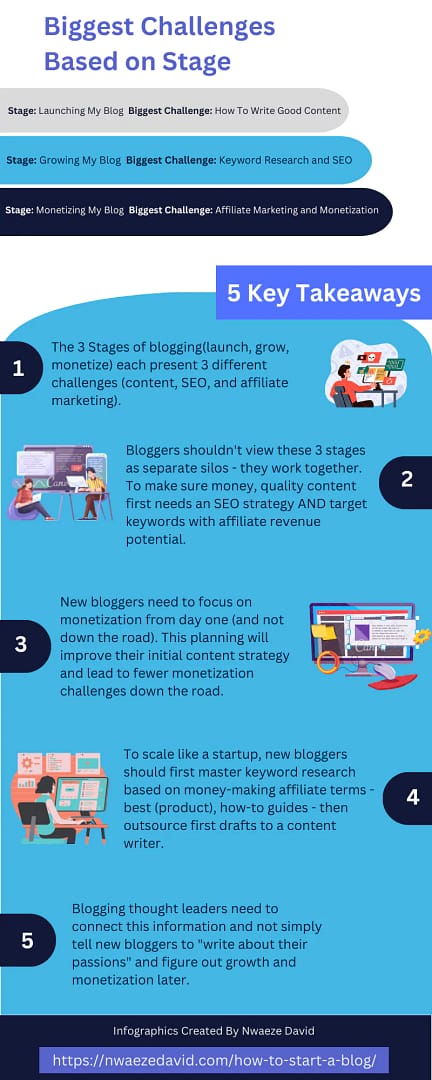
Using AI To Start Your Blog
There are so many great AI tools available today, you can use automation to optimize your blog and generate new content.
Here are a few of the best AI tools that can help you get started.
ChatGPT
Created by OpenAI, this tool can generate content with natural language processing.
ChatGPT can write blog posts faster and more naturally by typing in prompts.
Uniqueness is not its strong suit.
However, you can generate many ideas to help you find topics to write about.
Jasper AI
Jasper AI is an AI-driven writing assistant that can help you create copy for blog posts, emails, and other types of content.
This tool helps you quickly conceive ideas and offers suggestions on improving your content.
It’s a great way to save time when creating content ideas and editing existing work.
With plenty of templates and ideas to get you started, it’s easy to create high-quality content with Jasper.
ZimmWriter
ZimmWriter is a software that uses openAI API calls to write articles.
You’ll need an openAI account and API access to use it. This tool helps you quickly conceive ideas and offers suggestions on improving your content.
It’s a great way to save time when creating content ideas and editing existing work.
With plenty of templates and ideas to get you started, it’s easy to create high-quality content with ZimmWriter.
Surfer SEO
By analyzing a base target keyword and its related terms, Surfer SEO helps you to create content that directly answers your readers’ queries.
This tool will also provide insights into the types of content that perform best in search results and how often specific keywords are used.
Plus, it can help you track the performance of your content over time and give you tips on improving it.
Grammarly
Grammarly is an AI-powered writing assistant that helps you to improve your spelling and grammar.
It’s an excellent tool for bloggers who want to ensure their content is error-free and engaging.
In Summary: Starting a Blog is Easy
Well, as you can see, starting a blog is pretty easy.
Content strategies, link building, and monetization can be the tricky part.
Ultimately, your success with blogging comes down to how fast you can scale your content publishing and link-building efforts.
Because that’s how you rank on Google for valuable terms and make affiliate revenue – getting to page #1.
To recap, the seven steps we covered are:
- Choose a niche.
- Pick a blog name and web hosting.
- Install WordPress.
- Picking your blog’s theme.
- Install WordPress plugins.
- Create great content.
- Promote your blog.
However, making your first blog successful is hard work.
To read more about starting a blog, check out my other guides:
- How to Make Money Blogging
- Things I Wish I Knew Before I Started a Blog
Now, it’s your turn. Why not start a blog today?
FAQs
A blog is a regularly updated website run by an individual or group, primarily consisting of text in an informal, conversational style.
If statistics are anything to go by, in the United States alone, 42.23% of people aged 18 to 49 read blogs.
You can find a blog for any topic you want. For bloggers, it’s a great avenue to increase their subscriber base, connect with new people, and make money online.
There are so many reasons to start a blog.
One of the most prominent reasons is to influence and inspire online readers.
If you have in-depth knowledge in your field of work and decent writing chops, you can truly help others. Correct monetization of your blog can make you a decent passive income.
Blogging can provide you with the perfect platform to:
– Develop yourself personally
– Improve your writing
– Build new relationships and networks in your field
– Share your knowledge with your audience
– Make a lot of money
Speaking of money – this blog launched in 2018 and now makes over $100k/month.
You can use a free or paid blogging platform when you start a blog. Both have their pros and cons.
If you’re a novice and want to try your hand at blogging without paying upfront, WordPress.com and Blogger are excellent free platforms that let you do just that.
However, there are always restrictions on a free tool. For example, you won’t have access to better themes, restriction on advertisements, and more.
On the other hand, if you’re a seasoned campaigner or a novice confident enough about blogging, you could opt for paid platforms.
Website builders like Squarespace and Wix provide excellent paid plans that help you customize your site the way you want without restrictions.
Moreover, such platforms allow you to optimize your site for search engines and add advanced features like an online store, drag-and-drop editors, and more.
Here are some of the essential expenses:
– New domain name: It may cost you around $10 per year.
– Hosting: Shared hosting costs $3 – $10 per month. Then there are more advanced options like VPS hosting, dedicated hosting, etc.
– Optional expenses include a premium WordPress theme (costing between $30 – $60), marketing tools, additional SEO plugins needed, and those for other purposes.
Final Calculations:
– If you consider blogging a hobby, it should be free.
– If you aren’t that serious and don’t mind minimal features, it may cost you about $50-$60 per year.
Now, if you’re planning to go into blogging full-time and invest in additional features to scale up your blog, it may cost over $400 per year.
To get readers to your blog, you have to provide value to your readers. They will always come back for more value.
There are more than 600 million blogs in the US alone. But 95% of them aren’t successful.
Many factors set apart successful bloggers from non-successful ones.
Some of the critical factors in starting and running a successful blog are:
– Understanding market viability and audience revenue potential
– Being well versed in digital marketing – you need to have a firm grasp on SEO, keyword research, affiliate marketing, email marketing strategies, etc.
– Being great at self-promotion
– Offering value-based content
– Providing content consistently
– Creating a schedule and sticking to it
– Engaging subscribers proactively and solving their pain points
Yes, they do. Bloggers can get paid exceptionally well. Others make nothing from their blogs.
Breaking it down, bloggers mostly get paid through:
– Advertisements
– Affiliate marketing
– Online courses
– Sponsored posts
– Selling products
– Consulting
However, if your blog posts don’t offer much value, creating an income is difficult.
Bloggers can get paid via advertisements, affiliate commissions, course or eCommerce sales, and more. The most common metric on how much you get paid in affiliate marketing is EPC (earnings per click).
Another metric is CPM (cost per 1000 impressions). You get paid a fixed amount for every 1,000 clicks on the ad.
Apart from this, you can also sell products based on your expertise. For example, if you run a travel blog, you could sell brochures on the best tourist destinations.
Or, if you run a food blog, you could sell e-recipes of your best dishes.
Offer something valued by a segment of your audience and bring paid subscriptions to enlist them.
The amount could be as low as $5 per month per person. But if you can create the value to attract large volumes, you can start to make a decent income.
Yes, but it will take you a longer time to make money. Free platforms such as blogger.com and wordpress free version can get you started for free.
Starting a blog doesn’t have to cost much. You can start a blog with minimal investment and sometimes even for free.
When you start a blog, you must decide whether to self-host it or use a fully-hosted platform.
Usually, using a fully-hosted platform costs a small monthly fee. But getting a free platform is easy. Most blogging beginners opt for free, self-hosted platforms like WordPress.com and Blogger.
Here’s a list of some of the best blogging platforms (both paid and unpaid). If you’re serious about blogging, I recommend using a paid option.
When you use a free platform, you’ll have to abide by the platform restrictions and will rarely be able to blog and make money.
With almost unlimited revenue potential, you should pay to host your blog.
Food and recipes are some of the most popular things people search for.
Since everything is readily available, food connoisseurs are willing to try and experiment with different cuisines and flavors.
Now’s as good a time as any to start your food blog.
Here are some steps to do just that:
– Choose your web hosting company.
– Select a perfect name for your blog relevant to your niche.
– Choose the perfect theme for your food blog. A suitable theme can attract viewers instantly and help you increase your subscriber base.
– Perform keyword research and choose a sub-niche in the food space.
– Start posting and learn how to write recipes in an SEO-friendly manner.
– Get backlinks and guest posts from other food blogs.
– To sustain your blog, you might also want to find ways to monetize it.
Third-party advertisements, affiliate marketing, and selling exclusive recipes are some ways to do that.
Traveling is something that most people are passionate about.
If you are, too, you can start your travel blogging journey and make money from your blog recommendations.
Many travel affiliate programs pay when you recommend hotels, Airbnb, travel gear, travel insurance, etc.
Here’s how to get started now with a travel blog:
– The first step is to determine the sub-niche of your blog. There are plenty of options, including solo traveling, luxury traveling, budget traveling, family travel, and more.
– The second step is to decide on a name that’ll be an instant hit with your target audience.
– Set up web hosting.
– Get the perfect theme for your travel blog.
– Perform keyword research and choose a sub-niche in the travel space.
– Publish travel articles based on your expertise, and format them for SEO.
– Obtain backlinks and guest posts from other travel blogs.
If you’re interested in the latest styles, starting a fashion blog and tapping into that interest is a great idea.
However, it is a saturated space, so you must make extra efforts to start and grow your fashion blog.
Here’s how you can start your fashion blog:
– Think about what type of fashion you want to discuss in your blog. Fashion can be a broad term, so selecting a style or niche is essential. For example, do you want to blog about high or street fashion? Vintage or Gothic?
– Get the perfect domain name that will hit off instantly with the audience (don’t go with a free domain name with other brands in it).
– Choose your hosting provider.
– Select the theme that best suits your style and the fashion you want to discuss.
– Create content consistently. Never miss out on blogging.
– Promote it heavily, especially on social media platforms like Instagram.
– Since it’s fashion, you want to give it the maximum exposure. Monetize it through social media, podcasts, and advertisements. You need all the attention you can get.
If you are passionate about beauty products and the latest trends, starting a beauty blog could be for you.
This type of blog is best paired with a YouTube channel and Instagram account.
WordPress is the simplest way to make web pages and makes up over 30% of the Internet.
A WordPress site helps you create, publish, and share web pages. It’s also one of the most user-friendly platforms for hosting blogs. And you only have to pay for the domain name and web hosting.
It is a feature-rich CMS (content management system) that allows bloggers to create, edit, and publish content. It features a dashboard to edit posts, media, pages, comments, plugins, themes, users, website settings, and more.
WordPress.com and WordPress.org are two very different platforms.
WordPress.com offers an end-to-end solution to start a simple website for free. You need to sign up, and you are all set to build your website.
WordPress.org is an open-source website platform that can be leveraged only through a paid hosting account.
Here are some key differences between the two platforms to help you make a more informed decision:
1. Cost:
WordPress.org is free to test but to make the website visible and published; you need to buy website hosting and a domain name.
WordPress.com: You can start a free blog with a WordPress name. You will have to pay at least $4 monthly for a custom domain name.
2. Setup:
WordPress.org: Setting up a blog or website on WordPress.org requires some technical expertise, including buying hosting and domain name, followed by their integration with the website.
WordPress.com: WordPress.com guides the user in a step-by-step process to make the setup hassle-free.
3. Themes:
WordPress.org: It offers excellent customization options through more than 7,500 free themes. Users also get to choose thousands of premium themes.
WordPress.com: It comes with limited customization options. Free and personal plans offer over 150 themes, and other premium plans offer over 200 paid themes.
4. Plugins:
WordPress.org: You can access thousands of native and third-party plugins.
WordPress.com: It allows the installation of plugins in only business or eCommerce plans. These plans cost $25 and $45 per month and offer more than 50,000 plugins.
Now, it’s up to you to decide which platform aligns best with your requirements.
Taking backups should be done automatically by using plugins available for most blogging platforms.
Whether it’s your first year or your 5th, regularly backing up your blog should be a priority to ensure that if disaster strikes, you can pick yourself back up and continue as though nothing happened.
Yes, you can. A plugin from Amazon is specifically designed to allow people to do this.
The key to selling products is ensuring they are relevant and valuable to your current readership.
Yes, although there are strict rules about what Google accepts and don’t accept on their Adsense program.
Ensuring that you stay within the parameters of Google’s terms and conditions is the key to avoiding any difficulties in running these ads on your blog.
If you want to master Google AdSense and make more money with your blog, then you need to buy Google AdSense Master Guide.
Are you ready to start your blog? Get started for just $2.95/month (63% off your hosting plan) with my link below:
Be sure to join the Pro Blogging Academy to learn directly from me and my team.


What is AI and What Does it Mean for Technology?
This is quite interesting
Interesting to learn
Very interesting
Thanks for coaching
I will learn more from u.
This so great…This for this great opportunity
This post is very impactful nice one thanks for sharing
This is really good 👍
This is really amazing
This is amazing
Amazing
This is really great
That’s self explanatory
I like this
This is incredible
Nice one
Very Helpful and detailed. Thank you
This is very interesting to learn
Very helpful details I love this information
This is very helpful, thanks.